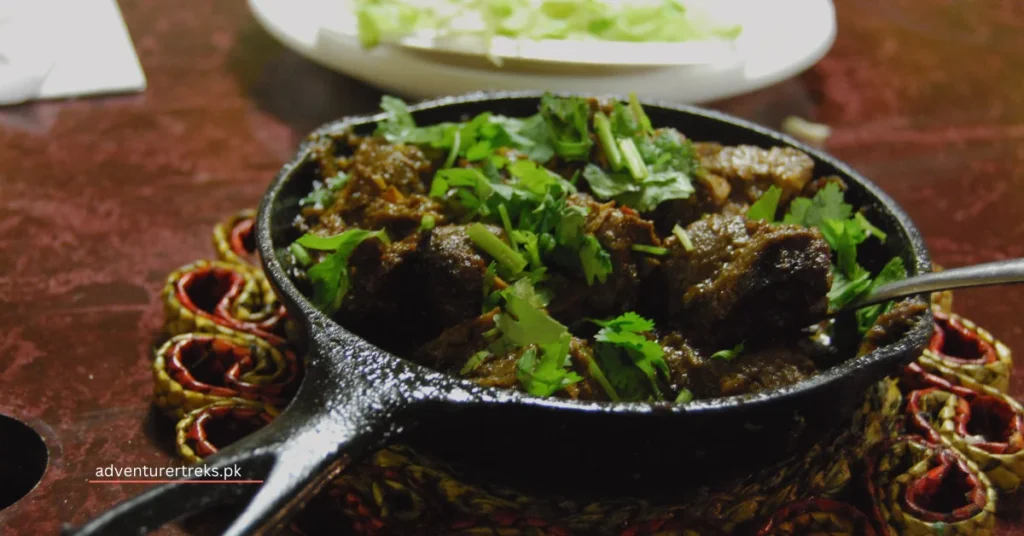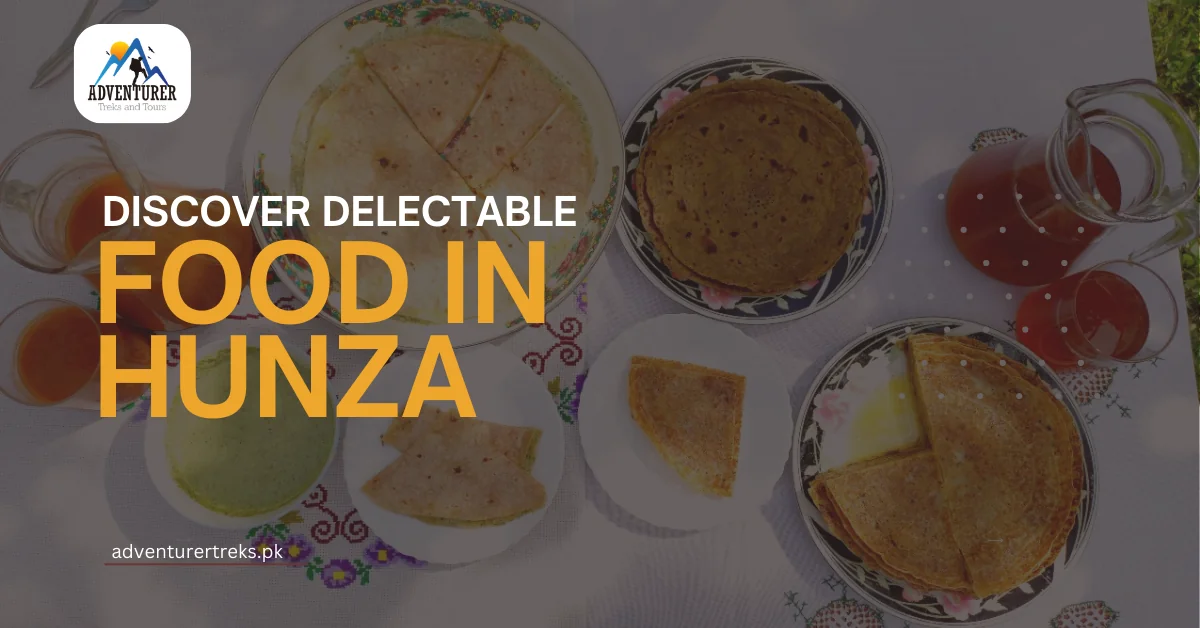Hunza is located in Pakistan’s far northern areas, particularly in Gilgit Baltistan. Hunza Valley is famous for its natural beauty and long, rich history. Many tourist spots in the Hunza Valley attract visitors to the Hunza. Moreover, many food vloggers and lovers have come to test and explore the taste of Hunza Valley’s food.
Hunza Valley is playing a significant role in its rich cultural heritage. The food in Hunza, especially traditional food, has its taste and flavor, making the Hunza Valley rich in cuisine. Many foods are baked using the traditional technique. The reason behind the popularity of food is the unique ingredients the Hunza Valley offers.

Thus, if you are a food lover and food vlogger, you must try to explore the food in Hunza. Additionally, if you are looking for guidance, don’t worry. We are here to help you with the food of Gilgit Baltistan, particularly in Hunza.
Food in Hunza
In the introductory portion, we have already discussed the traditional and famous dishes of Gilgit Baltistan. Natural beauty and a long, rich food history allow the people here in Hunza to explore and taste the traditional food flavors in Gilgit Baltistan.
People worldwide visit the Gilgit Baltistan and discover new natural beauty spots at Hunza Valley. Moreover, the local people of Hunza Valley are loving, caring, humble and hospitable.
Following are the common ingredients and famous dishes mentioned.
Common ingredients
Several ingredients produced in the Hunza Valley make the flavourful recipe. The people of Hunza gain the ingredients from the meat, like mutton and beef or chicken; for this, they keep the livestock and use it for their benefit. The people of Hunza plants also have vegetables. It would be best to try the recipe, which is prepared with local ingredients.
Wheat: Wheat is perceived as the basic ingredient in the Hunza Valley, and through wheat, we can prepare many alternative foods like flour of wheat used everywhere, which is used for several breads daily. For instance, roti and chapatti are used as ingredients daily.
Yak meat: yak meat is a very significant ingredient in Hunza, and it is very popular among the people of Hunza as well as the visitor who comes to visit the Hunza from across the globe and taste the meat of yak or anything else that is made up of yak meat; thus they enjoy their meal.
Dairy products: dairy products play the most significant role in Hunza Valley, especially butter, cheese, and yogurt, producing dairy. In addition, dried yogurt, called kashk in the local language, is mostly used for soups and gravies in winter weather. Fresh dairy products are used daily and on special occasions or festivals.
Potatoes: potatoes are the popular ingredients in Hunza Valley. These are mixed while making many other vegetables and are also used in pakora and samosa, making the samosa and pakora crispy. Potatoes are used in many amounts as compared to other vegetables.
Green leafy vegetables: green leafy vegetables contain multiple nutrients, Vitamin C and K, and many other minerals that work as antioxidants. Green leafy vegetables are produced in great amounts at Hunza Valley.
Popular dishes
Hunza’s winsome, lush green scenery has a rich cultural history of delicious foods. The many types of meals in the traditional food in Hunza reflect the area’s natural tastes and cultural stress. Some of the most famous foods in Hunza are mentioned below.
Chapshuro:
Chapshuro is a distinct dish with a crustless Hunza pie packed with ground pork, spices, onions, and other flavourful ingredients. Tourists must go once to experience the Chapshuro of Hunza. Chapshuro looks like a pizza, and it is made with hot mutton, traditionally yak meat or minced beef. The meat is then collected into a dough and gradually fried, mixed with a fairly simple fusion of chopped onions, chilies, coriander, and small tomatoes.
Gyaling or Gral:
Gyaling or gral are also found in Hunza. Gral or Gyaling is wheat bread shaped with various pancakes and is thin and flexible.
Mainly served in a mountain, this dish is dipped in apricot oil or butter from local cows. Food items for Hunza spread out on a hearthrug. This yellow oil is just one of several similar flavors extensively available in Hunza while being expensive in most other parts of the world.
In particular, it is served with breakfast; Gyaling/Gral is always served with namkeen chai or herbal chai in the Hunza culture. It will make you happy before you begin one of the several hikes in Pakistan.
Molida:
Molida is the most famous old-age food in Gojal and central Hunza. The taste of Molida is like macaroni and cheese. Molida is a flavourful recipe, and the mixture is made of many things, like pieces of wheat shape, apricot oil, butter, and milk.
Yak meat:
Yak meat is a very significant ingredient in Hunza, and it is very popular among the people of Hunza as well as the visitors who come to visit the Hunza from across the globe and taste the meat of yak or anything else that is made up of yak meat; thus they enjoy their meal. From December to January, the residents of Hunza use yak meat extensively.
Buttering duodo:
Buttering duodo a famous soup of Hunza mainly served during the winter season known as buttering doudo. The taste becomes unique when they mix the dried apricots. This soup has a unique taste formed by utilizing popular apricots from the area, such as sugar, water, and lemon. Although doudo comes in different forms, never forgettable tastes like this.
Popular beverages
Hunza Valley is famous for natural beauty and food and is popular due to its important and tasty drinks. Hunza Valley offers many drinks that are deeply linked to cultural heritage. These drinks have a distinct position in the culture of Hunza. Some of those famous drinks are mentioned below.
Chamus: Chamus is a tasty and flavourful drink mainly served after meals. Drinking Chamus made people feel refreshed at that time. Chamus is good for your well-being, nourishing, and tasty. Once you drink it, you will prepare for another round. The hot water and apricots make it.
Gulli Chill: Gulli Chill, or apricot water, is a famous drink in the Hunza. The Gulli chill is mainly used in summer to quench the thirst. It is better in the season of hot days.
Hunza Chai: Hunza chai is a famous tea in the Hunza region. Most people take this kind of tea daily. The taste and flavor of tea is rich because it has a salty taste. The water, salt and tea leaves make it.
Tumuro chai: Tumuro tea is significant in Hunza Valley. Usually, people who live in the mountains use the Tumuro chai extensively. It is also called green tea, which is utilized mainly during the winter because it keeps the body warm in the cold weather, which people living at high altitudes use extensively.
Modern influences and changes
The fast means of communication and transportation have changed our way of life. We are living in a technological advancement and innovative era. Globalization has introduced the concept of interdependence because one nation is dependent on another in the contemporary world.
Hence, globalization has influenced the food culture of specific regions and is shifting into internationalism.
Impacts of tourism
As we know, the Hunza Valley is a wonderful spot for tourism; most visitors from across the world visit every year to enjoy the different seasons of Hunza Valley. Therefore, they bring their food culture with them. Owing to modernization, the food culture in Hunza will change into one of internationalism.
Impacts of technology
The world has been changed owing to technological advancement. Through communication and transportation, interdependence has increased. Therefore, inspired by international restaurants, people opened hotels and restaurants in the shape of international hotels.

Customized Tour Packages for Pakistan
Plan the trip of your dreams with our customized packages tailored to your interests, preferences and above all, your budget.
Conclusion
Overall, Hunza Valley is a wonderful place for tourism. Hunza Valley offers many outdoor activities, like hiking, skating, boating, and fishing, which are the most famous activities that attract visitors to the Hunza Valley.
Subsequently, Hunza Valley also offers opportunities to food lovers or food vloggers interested in exploring Hunza Valley’s food culture. The food culture of Hunza Valley has a long, rich history. In contrast, modernization is influencing the traditional food culture of Hunza.








Comments are closed.